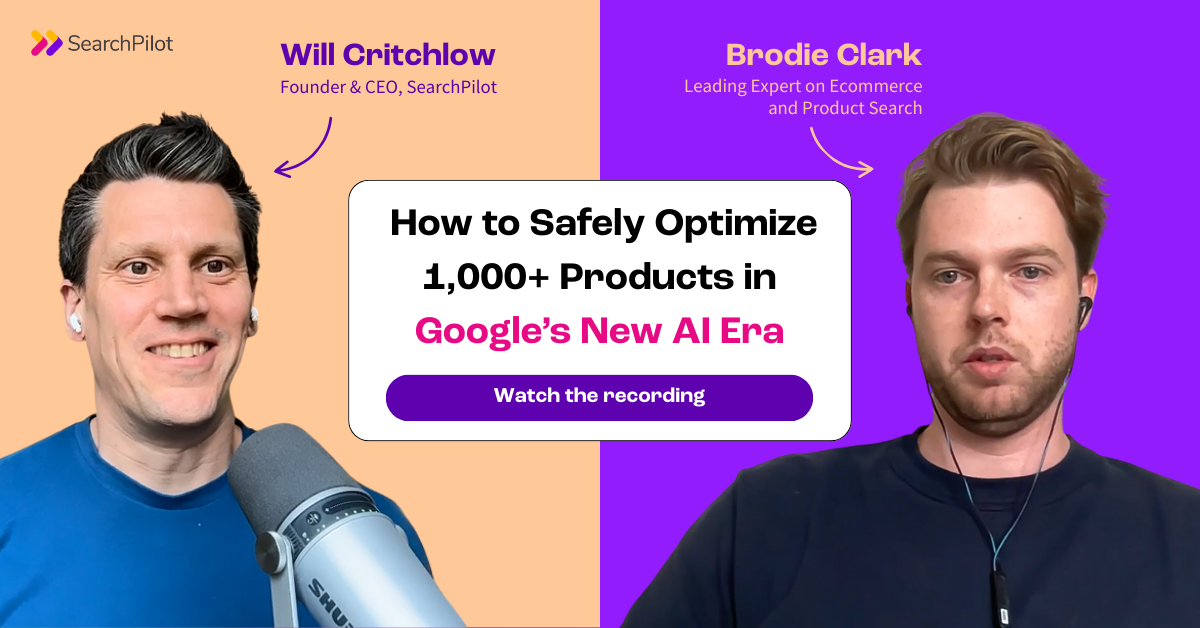Following my recent webinar as an SEO Consultant at SearchPilot, I wanted to share how Google’s Shopping features and AI experiences are reshaping the role of product listing pages (PLPs) in ecommerce.
In the session, I walked through live SERP examples, the evolving purchase funnel, and what testing programs need to adapt when product detail pages (PDPs) increasingly appear before PLPs.
View Demetria's webinar slides here.
Three recent product updates relevant to this discussion
-
GEO testing: run controlled experiments across entire markets to measure SEO changes at scale.
-
GEO testing methodology explained: a deep look at how geographic testing works and when to use it.
-
Product search testing: a framework for testing in Google’s evolving product and Shopping SERPs.
SearchPilot’s mission is clear: put search in control mode. By running controlled SEO experiments at scale, leaders can stop guessing, prove impact, and grow search as a true performance channel.
Key takeaways
-
PLPs are still strategic but less likely to be the first touchpoint on high intent queries.
-
PDPs dominate Shopping features, making feed accuracy and SERP presentation critical.
-
Testing programs should include page content, site structure, schema, and Merchant Center.
-
Measurement must separate surfaces to identify where growth originates.
Shared realities: crowded SERPs and PDP-first results
Ecommerce SERPs are more crowded than ever. Sponsored products, Popular products, image packs, suggested searches, and deal modules now dominate high intent searches. In many cases, the first PLP blue link sits well below the fold, while PDPs populate Shopping features at the top of the page.

Market differences add another layer of complexity. In the US, filter features and Shopping blocks often dominate. In the UK, filters are absent and image packs appear higher. Examples from India showed Popular products at the top without sponsored results, while Japan placed images before Shopping. Heavy equipment queries looked cleaner, while pet searches removed Shopping modules altogether.
Implication: strategies must adjust by market and by vertical.
The funnel has shifted: research inside Google, clicks to PDPs
In the traditional funnel, PLPs played a central role during the interest and consideration phases. Today, much of this activity happens inside Google.
Awareness, interest, and consideration are shaped by Shopping modules, AI overviews, and third-party content surfaced directly in SERPs. Shoppers often make decisions before clicking through. The first site touchpoint is increasingly a PDP, not a PLP.

Google’s AI mode compresses this further. A general query such as “best sweater for layering” can immediately return a product recommendation inside the AI experience. One click later, the shopper is on a PDP, bypassing PLPs entirely. PLPs still have value, but their role is shifting toward brand navigation, loyalty-driven return visits, and supporting PDP visibility through internal linking.
Where PLPs can and cannot compete
PLPs do not appear in Popular products or other Shopping modules. These are PDP-only placements.
PLPs still contribute in:
-
Traditional 10 blue link rankings
-
Explore brands features and some image packs
-
AI overview citations (though traffic is currently limited)
-
Internal linking structures that pass authority to PDPs
PDPs, by contrast, dominate Shopping modules, can appear in blue links and image packs, and benefit from schema, breadcrumbs, and clear parent–child relationships.
The practical takeaway: treat PLPs and PDPs as a system. PLPs provide authority and discovery while PDPs secure visibility in Shopping.
Testing priorities for ecommerce SEO
I've outlined a testing roadmap for ecommerce teams.
On PLPs
-
Above-the-fold copy that aligns with query intent
-
Product card design highlighting price, availability, and delivery information
-
FAQs addressing common buyer questions
-
Clean heading hierarchies that signal page relevance
-
Distinct title tags and meta descriptions at scale
Site structure and linking
-
Internal links from PLPs to priority PDPs
-
Consistent breadcrumb structure
-
Pagination and products-per-page experiments to balance crawl depth and link flow
Schema and Merchant Center
-
ItemList schema on PLPs where supported
-
Product, Review, and Offer schema on PDPs
-
Returns and shipping data aligned across schema and Merchant Center feeds
SERP appearance
-
Accurate review signals, pricing, and delivery promises
-
Titles and metas crafted for CTR as well as relevance
Measurement beyond organic traffic
Aggregating performance into a single organic metric no longer reflects reality. Ecommerce teams need to know whether gains are coming from traditional blue links or from Shopping modules.
This is why SearchPilot’s new multi-metric tracking separates blue link clicks, Shopping clicks, and impressions. By understanding where clicks come from, teams can diagnose whether visibility issues stem from ranking, presentation, or feed accuracy.

Put search in control mode with SearchPilot
Google’s Shopping features are reshaping how PLPs and PDPs appear, and how ecommerce teams need to think about testing. SearchPilot makes SEO measurable by running controlled experiments across category pages, product detail pages, navigation, and content. Results are delivered with clear timelines and confidence, so teams can move from guesswork to predictable growth.
For ecommerce teams tackling product grids, Merchant Center feeds, or variant handling, the first step is a focused test plan. That means reviewing feed quality, encoding variant attributes in titles, strengthening image coverage, and setting up experiments that reflect how shoppers filter and buy. Measurement tracks impressions, clicks, and revenue so leaders can see the real impact.
Stop trying to predict the future. Experiment to discover it. If you want tailored test ideas for your top PLPs and PDPs, schedule a demo and we will share a starter list and a clear path from validation to velocity to control.



